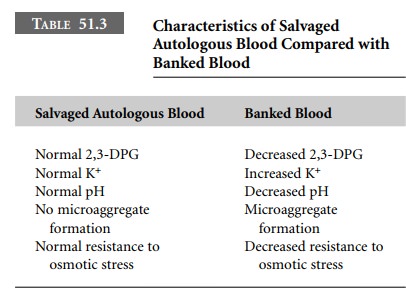Chapter: Clinical Cases in Anesthesia : Blood Replacement
Outline the characteristics of blood obtained by cell salvage
Outline the characteristics of blood obtained by cell salvage.
Salvaged autologous blood differs from banked
blood and other sources of autologous blood in many ways. Salvaged autologous
blood is basically a suspension of red cells in saline. The Hct of salvaged
blood may vary depend-ing on the amount of blood collected from the field but
is typically in the 50–60% range. Once processed, salvaged blood contains
essentially no clotting factors or platelets. If large volumes of salvaged
blood are used to replace surgi-cal blood loss, dilutional thrombocytopenia and
low levels of clotting factors may result. Salvaged blood does not exhibit the
storage lesion that is present in banked blood (Table 51.3). The
2,3-diphosphoglycerate (2,3-DPG) level of salvaged blood is normal, and it does
not exhibit the low pH, elevated potassium, and microaggregate formation found
in banked blood. Chromium-labeling studies have shown that salvaged red cells
have normal survival times in the body once they are reinfused. Furthermore,
indices of red cell viability, such as resistance to osmotic stress, are
superior in salvaged blood compared with banked blood.

Related Topics